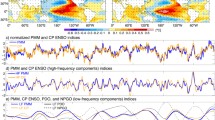Abstract
Mechanisms for the spatio-temporal development of the Tropical Pacific Meridional Mode (TPMM) are investigated using a coupled ocean-atmosphere model and observations. In both observations and the model, this meridional mode displays decadal variations and is most pronounced in spring and early summer. The model simulation suggests that once SST anomalies in the subtropical northeastern Pacific are initiated, say by northeasterly trade wind variability, perturbations evolve into a merdional dipole in 2–3 months. A wind-evaporative-SST feedback causes a southwestward propagation of initial subtropical SST anomalies, while anomalous equatorial upwelling helps form the southern lobe of the meridional dipole. The TPMM development is a fast process (a few months) and depends on the seasonal cycle.
Similar content being viewed by others
References
Alexander, M. A., I. Blade, M. Newman, J. R. Lanzante, N. C. Lau, and J. D. Scott, 2002: The atmospheric bridge: The influence of ENSO teleconnections on air-sea interaction over the global oceans. J. Climate, 15, 2205–2231.
Bretherton, C. S., C. Smith, and J. M. Wallace, 1992: An Intercomparison of Methods for Finding Coupled Patterns in Climate Data. J. Climate, 5, 541–560.
Chang, P., L. Ji, and H. Li, 1997: A decadal climate variation in the tropical Atlantic Ocean from thermodynamic air-sea interactions, Nature, 385, 516–518.
Chang, P., L. Zhang, R. Saravanan, D. J. Vimont, J. C. H. Chiang, L. Ji, H. Seidel, and M. K. Tippett, 2007: Pacific meridional mode and El Niñno-Southern Oscillation. Geophys. Res. Lett., 34, L16608, doi: 10.1029/2007GL030302.
Chiang, J. C. H., and D. J. Vimont, 2004: Anologous Pacific and Atlantic Meridional Modes of tropical atmosphere-ocean variability. J. Climate, 17, 4143–4158.
Davey, M., and Coauthors, 2002: STOIC: A study of coupled model climatology and variability in tropical ocean regions. Climate Dyn., 18, 403–420.
Jacob, R. L., 1997: Low frequency variability in a simulated atmosphere ocean system. Ph.D. dissertation, University of Wisconsin-Madison, 155pp.
Klein, S. A., B. J. Soden, and N. C. Lau, 1999: Remote sea surface temperature variations during ENSO: Evidence for a tropical atmospheric bridge. J. Climate, 12, 917–932.
Liu, Z., J. Kutzbach, and L. Wu, 2000: Modeling climate shift of El Niño variability in the Holocene. Geophys. Res. Lett., 27, 2265–2268.
Okajima, H., S.-P. Xie, and A. Numaguti, 2003: Interhemispheric coherence of tropical climate variability: Effect of the climatological ITCZ. J. Meteor. Soc. Japan, 81, 1371–1386.
Vimont, D. J., D. S. Battisti, and A. C. Hirst, 2001: Footprinting: A seasonal connection between the tropics and mid-latitudes. Geophys. Res. Lett., 28, doi: 10.1029/2001GL013435.
Vimont, D. J., J. M. Wallace, and D. S. Battisti, 2003: The seasonal footprinting mechanism in the Pacific: Implications for ENSO. J. Climate, 6, 2668–2675.
Wang, C., and J. Picaut, 2004: Understanding ENSO physics—A review. Geophysical Monograph, 147, AGU, Washington D. C., 1–19.
Wu, L., Z. Y. Liu, C., Li, and Y. Sun, 2007: Extratropical control of recent tropical Pacific decadal climate variability: A relay teleconnection. Climate Dyn., 28, 99–112.
Wu, S., 2008: The main modes of local ocean-amosphere interaction in north Pacific and its impacts on tropical Pacific. Ph.D dissertation, Ocean University of China, 143pp.
Xie, S.-P., 1999: A dynamic ocean-atmosphere model of the tropical Atlantic decadal variability. J. Climate, 12, 64–70.
Author information
Authors and Affiliations
Corresponding author
Rights and permissions
About this article
Cite this article
Wu, S., Wu, L., Liu, Q. et al. Development processes of the Tropical Pacific Meridional Mode. Adv. Atmos. Sci. 27, 95–99 (2010). https://doi.org/10.1007/s00376-009-8067-x
Received:
Revised:
Published:
Issue Date:
DOI: https://doi.org/10.1007/s00376-009-8067-x




